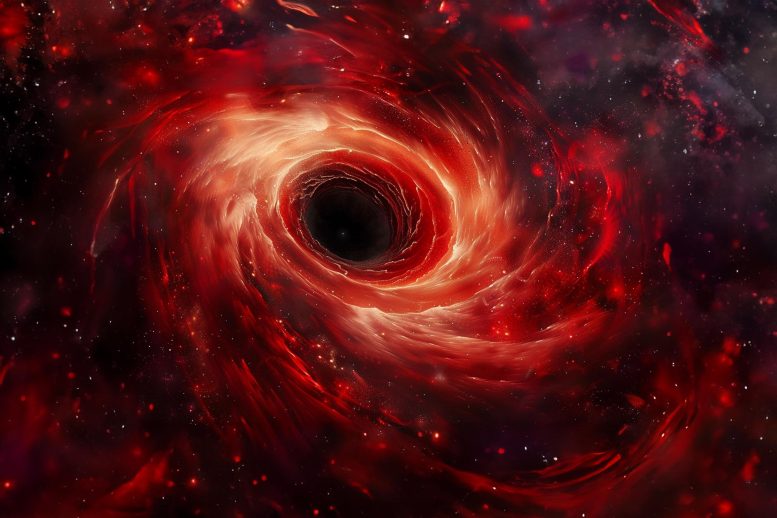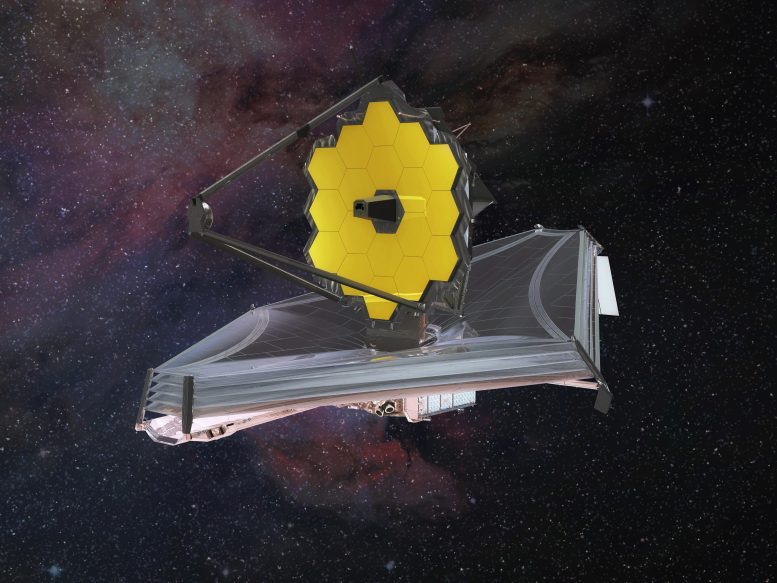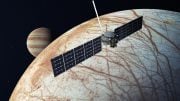
A team of astronomers using the JWST has discovered an unusually red, gravitationally lensed supermassive black hole from the early universe, revealing it to be significantly larger relative to its host galaxy than previously observed examples. This finding challenges our understanding of the relationship between black holes and galaxies in the early cosmos. Credit: SciTechDaily.com
JWST images reveal a supermassive black hole in the early universe, notable for its massive size compared to its host galaxy and obscured by thick dust.
Analyzing images from the James Webb Space Telescope (JWST), a group of astronomers led by Dr. Lukas Furtak and Prof. Adi Zitrin from Ben-Gurion University of the Negev has detected an extremely red, gravitationally lensed supermassive black hole in the early Universe. Its colors suggest that the black hole lies behind a thick veil of dust obscuring much of its light. The team managed to measure the black hole mass and discovered that it was significantly more massive, compared to its host galaxy, than what has been seen in more local examples. The finding was published in Nature two weeks ago.
JWST: Unveiling Early Universe Mysteries
The JWST, launched two years ago, has revolutionized our view of early galaxy formation. It has led to the detection of very early galaxies in greater abundances and greater brightnesses than previously predicted, and revealed some new types of objects.
A Quasar-Like Discovery
The group of astronomers had detected in JWST images what seemed to be a lensed, quasar-like object from the early universe. Quasars are bright active galactic nuclei: supermassive black holes in the centers of galaxies that are actively accreting material.

The James Webb Space Telescope is the next great space science observatory, designed to answer outstanding questions about the Universe and to make breakthrough discoveries in all fields of astronomy. Credit: Northrup Grumman
The Power of Gravitational Lensing
The accretion of material onto the black hole emits copious amounts of radiation that overshine the host galaxy, leading to a compact and bright, star-like appearance. The JWST images in which Furtak and Zitrin identified the object were taken for the UNCOVER program (PIs: Ivo Labbé, from Swinburne University of Technology, and Rachel Bezanson from the University of Pittsburgh), which imaged the field of a cluster of galaxies, Abell 2744, to an unprecedented depth. Since the cluster contains large amounts of mass it bends spacetime — or the paths of light rays traveling near it — effectively creating a gravitational lens. The gravitational lens magnifies the background galaxies behind it and allows astronomers to observe even more distant galaxies than otherwise possible.
The Red Dot Phenomenon
“We were very excited when JWST started sending its first data. We were scanning the data that arrived for the UNCOVER program and three very compact yet red-blooming objects prominently stood out and caught our eyes,” says Dr. Lukas Furtak, a postdoctoral researcher at BGU and the lead author of the discovery papers. “Their “red-dot” appearance immediately led us to suspect that it was a quasar-like object.”
Unraveling the Mystery
Furtak and the UNCOVER group started investigating the object. “We used a numerical lensing model that we had constructed for the galaxy cluster to determine that the three red dots had to be multiple images of the same background source, seen when the Universe was only some 700 million years old,” says Prof. Zitrin, an astronomer at BGU and one of the lead authors of the discovery papers.
A Supermassive Breakthrough
“Analysis of the object’s colors indicated that it was not a typical star-forming galaxy. This further supported the supermassive black hole hypothesis,” says Prof. Rachel Bezanson, from University of Pittsburgh and co-lead of the UNCOVER program. “Together with its compact size, it became evident this was likely a supermassive black hole, although it was still different from other quasars found at those early times,” Prof. Bezanson added. The discovery of the uniquely red and compact object was published last year in the Astrophysical Journal. But that was just the beginning of the story.
Spectral Insights and Surprises
The team then acquired JWST/NIRSpec data of the three images of the “red dot” and analyzed the data. “The spectra were just mind-blowing,” says Prof. Ivo Labbé, from Swinburne University of Technology and co-lead of the UNCOVER program, “By combining the signal from the three images together with the lensing magnification, the resulting spectrum is equivalent to ~1700 observing hours by JWST on an unlensed object, making it the deepest spectrum JWST has obtained for a single object in the early universe,” says Prof. Labbé.
“Using the spectra, we managed to not only confirm that the red compact object was a supermassive black hole and measure its exact redshift, but also obtain a solid estimate for its mass from the width of its emission lines,” says lead author Dr. Furtak. “Gas is orbiting in the gravitational field of the black hole and achieves very high velocities that are not seen in other parts of galaxies. Because of the Doppler shift, light emitted by the accreting material is red-shifted on one side and blue-shifted on the other side, according to its velocity. This causes emission lines in the spectrum to become broader.”
A Galaxy Overshadowed
But the measurement led to yet another surprise, published in Nature two weeks ago: the black hole’s mass seems to be excessively high compared to the host galaxy’s mass.
“All the light of that galaxy must fit within a tiny region the size of a present-day star cluster. The gravitational lensing magnification of the source gave us exquisite limits on the size. Even packing all the possible stars into such a small region, the black hole ends up being at least 1% of the total mass of the system,” says Prof. Jenny Greene from Princeton University and one of the lead authors of the recent paper. “In fact, several other supermassive black holes in the early Universe have now been found to show a similar behavior, which lead to some intriguing views of black hole and host galaxy growth, and the interplay between them, which is not well understood.”
The Cosmic Chicken and Egg Dilemma
Astronomers do not know if such supermassive black holes grow, for example, from stellar remnants, or perhaps from material that directly collapsed into black holes in the early Universe.
“In a way, it’s the astrophysical equivalent of the chicken and egg problem,” says Prof. Zitrin. “We do not currently know which came first – the galaxy or black hole, how massive the first black holes were, and how they grew.”
Future Insights From JWST
Since many more such “little red dots” and other active galactic nuclei have recently been detected with JWST, hopefully, we will have a better idea soon.
Reference: “A high black hole to host mass ratio in a lensed AGN in the early Universe” by Lukas J. Furtak, Ivo Labbé, Adi Zitrin, Jenny E. Greene, Pratika Dayal, Iryna Chemerynska, Vasily Kokorev, Tim B. Miller, Andy D. Goulding, Anna de Graaff, Rachel Bezanson, Gabriel B. Brammer, Sam E. Cutler, Joel Leja, Richard Pan, Sedona H. Price, Bingjie Wang, John R. Weaver, Katherine E. Whitaker, Hakim Atek, Ákos Bogdán, Stéphane Charlot, Emma Curtis-Lake, Pieter van Dokkum, Ryan Endsley, Robert Feldmann, Yoshinobu Fudamoto, Seiji Fujimoto, Karl Glazebrook, Stéphanie Juneau, Danilo Marchesini, Micheal V. Maseda, Erica Nelson, Pascal A. Oesch, Adèle Plat, David J. Setton, Daniel P. Stark and Christina C. Williams, 14 February 2024, Nature.
DOI: 10.1038/s41586-024-07184-8









Be the first to comment on "Supermassive Black Hole Challenges Cosmic Theories – “The Spectra Were Just Mind-Blowing”"